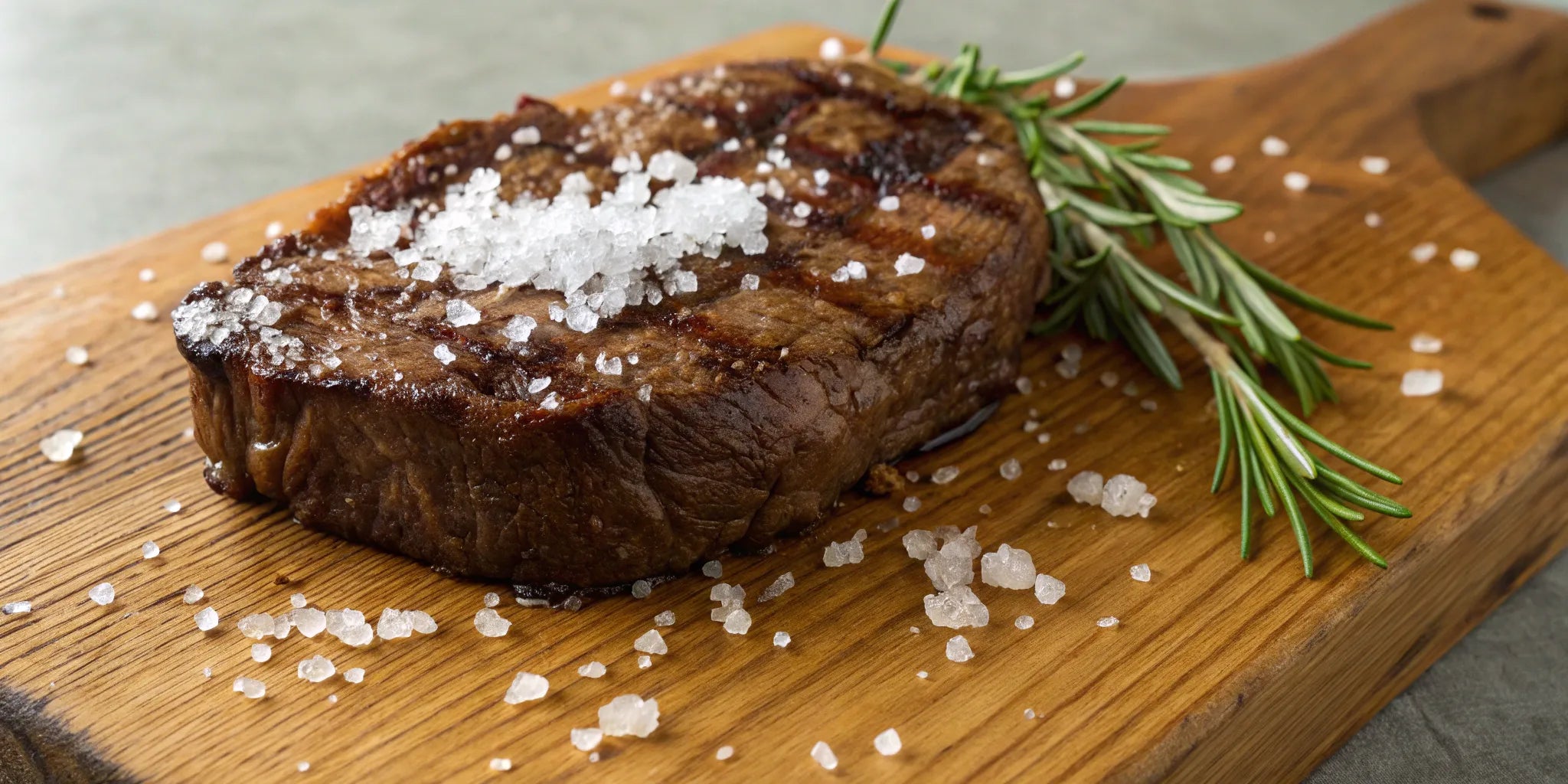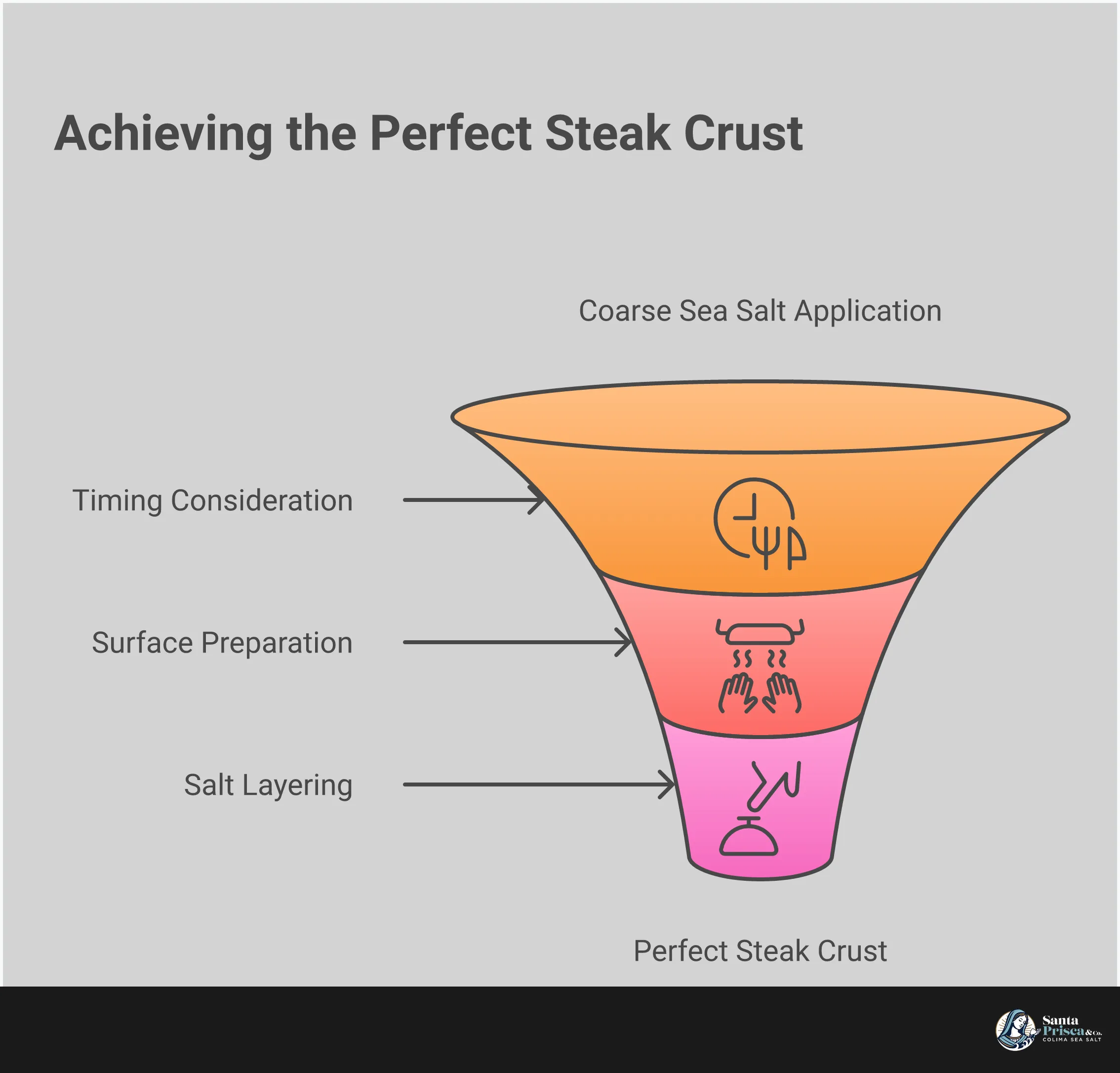The Art of Using Coarse Sea Salt for Steak
Written By Santa Prisca & Co Staff Last updated on
Have you ever bought a beautiful, expensive cut of steak, only to be disappointed by a lackluster crust and uneven flavor? It’s a common frustration, but the solution is surprisingly simple. The problem often comes down to two things: surface moisture and the wrong kind of salt. A steak that isn’t properly dried will steam instead of sear, and fine table salt dissolves too quickly, risking an overly salty bite. The key to a consistently perfect sear is using a high-quality coarse sea salt for steak. Its larger crystals help manage moisture and season evenly, creating that coveted crust every single time.
Key Takeaways
- Choose a Mineral-Rich Coarse Salt: The large, flaky crystals of an unrefined sea salt are key for building a perfect crust and adding complex, nuanced flavor that fine table salt simply can't offer.
- Understand the Two Salting Windows: For a deeply flavorful and tender steak, timing is crucial. Salt either just before the steak hits the heat for a great surface crust, or at least 40 minutes prior to let the salt work as a dry brine, seasoning the meat from within.
- Start with a Perfectly Dry Surface: Moisture is the enemy of a great sear. Always pat your steak completely dry before seasoning to ensure the salt adheres properly and the heat creates a rich, caramelized crust instead of just steaming the meat.
Why Coarse Sea Salt Matters for Steak
Preparing a beautiful cut of steak is a ritual. It’s an act of intention, from selecting the meat to that final, satisfying sear. But in the pursuit of perfection, one of the most crucial ingredients is often overlooked: the salt. The right salt does more than just add flavor; it fundamentally transforms the texture and taste of the meat, creating a restaurant-quality experience right in your own kitchen.
Not all salt is created equal. The fine, iodized table salt hiding in your pantry simply won’t do. For a truly exceptional steak, you need a coarse, unrefined sea salt. The large, irregular crystals of a hand-harvested salt like our Colima Sea Salt are essential. Their size, mineral content, and interaction with the meat’s surface are what create that deeply browned, flavorful crust and tender, juicy interior we all crave. Let’s explore why these coarse crystals are the secret to a flawless steak.
How Crystal Size and Texture Affect Flavor
Imagine the sound and feel of a perfect steak crust. That satisfying crunch gives way to a tender, juicy bite. This experience begins with the texture of your salt. Coarse sea salt crystals are large and irregular, so they don’t dissolve instantly on the meat’s surface. Instead, they stand up to the high heat of the pan or grill, forming a spectacular, caramelized crust.
This larger grain size also gives you more control. When you pinch and sprinkle coarse salt, you can see exactly where the crystals land, ensuring an even coating without accidentally over-salting. It’s a more mindful, tactile approach to seasoning that connects you to the cooking process and delivers a more consistent, delicious result every time.
The Role of Natural Minerals in Flavor
When you choose an unrefined sea salt, you’re getting so much more than just sodium chloride. Unlike processed table salt, which is stripped of its natural components, true sea salt contains a wealth of health-promoting trace minerals like potassium, magnesium, and calcium. These elements are a gift from the earth, absorbed from the ocean and the land where the salt is harvested.
These minerals don’t just offer wellness benefits; they contribute to a more complex and nuanced flavor. Instead of a sharp, one-dimensional saltiness, you get a gentle, rounded taste with a clean finish. Our Colima Sea Salt, naturally filtered through volcanic earth, carries a subtle mineral depth that enhances the rich, savory notes of the beef without overpowering them.
How Salt Transforms Meat
The magic of salting a steak happens long before it hits the heat. When you season your steak with coarse salt, a process called osmosis begins. The salt crystals on the surface draw moisture out of the meat. This moisture then dissolves the salt, creating a natural brine that is slowly reabsorbed back into the muscle fibers.
This simple interaction does two incredible things. First, it seasons the steak from the inside out, ensuring every bite is flavorful. Second, it helps break down the proteins in the meat, resulting in a more tender texture. This dry brining method is the key to achieving a steak that is both deeply seasoned and incredibly juicy.

Choose the Right Sea Salt for Your Steak
Selecting the right salt for your steak is an act of intention. It’s about more than just flavor; it’s about honoring the ingredient and understanding how a simple crystal can transform a meal. When you choose a salt with care, you’re setting the stage for a truly memorable dish. The perfect sea salt doesn’t just season the meat—it draws out its inherent richness and creates a crust that is deeply satisfying.
What to Look for in a Quality Sea Salt
The best sea salt is the one that has been touched the least. Look for unrefined salts that are hand-harvested, as they retain their natural character and complexity. When salt undergoes very little processing, it holds onto a beautiful spectrum of health-promoting trace minerals that refined table salt lacks.
Our Colima Sea Salt, for example, is naturally filtered through volcanic earth, which gives it a unique mineral profile and a clean, crisp flavor. You’ll notice the difference not just in the taste, but in the texture—a delicate, flaky crunch that melts on the tongue.
Why Grain Size Matters
Have you ever wondered why chefs prefer coarse salt for steak? It’s all about control and texture. While the sodium content of sea salt and table salt is the same by weight, their crystal structures behave very differently. Fine grains dissolve instantly, risking an overly salty bite.
Coarse sea salt, with its larger, more irregular crystals, dissolves slowly. This gradual process allows the salt to draw moisture from the steak’s surface, creating the foundation for a perfect crust without making the meat too salty. It’s a gentle seasoning that builds layers of flavor.
How to Store and Handle Sea Salt
A beautiful, mineral-rich sea salt deserves to be treated with care. To maintain its integrity, it’s important to protect it from its two biggest enemies: moisture and contaminants. Store your salt in a cool, dry place, away from the steam of the stove.
A simple wooden salt cellar or an airtight glass jar is perfect for this. Proper storage ensures your salt remains free-flowing and preserves the delicate structure of its crystals. This simple ritual of care helps you get the most from this incredible natural ingredient every time you cook.
Find the Perfect Time to Salt Your Steak
Timing is everything, especially in the kitchen. Just as we choose ingredients with intention, the moment we choose to season a beautiful cut of steak can transform it from good to truly memorable. When you work with a salt as pure and mineral-rich as our Colima Sea Salt, understanding the art of timing honors both the ingredient and the meal you’re about to create. The process is simple, but the results are profound, creating a steak that is deeply flavorful and incredibly tender. It’s a small act of patience that pays off in every single bite.
What is Dry Brining?
Dry brining is a simple yet powerful technique that uses salt to season meat from the inside out. When you sprinkle coarse sea salt over a steak, a bit of magic begins. The salt crystals draw moisture from the surface of the meat, creating a concentrated brine. This flavorful liquid is then reabsorbed deep into the muscle, carrying the salt with it. This process not only seasons the steak thoroughly but also helps break down proteins, resulting in a more tender texture. Using a coarse, unrefined sea salt is key here; its larger grains dissolve slowly, giving the meat time to absorb the seasoning without becoming overly salty.
Identify the Best Pre-Cooking Window
To get the most out of your dry brine, timing is crucial. The ideal window for salting your steak is either immediately before cooking or at least one hour beforehand. Salting right before you place the steak on the heat seasons the surface and helps form a beautiful crust. For a deeper, more integrated flavor, salting at least an hour in advance (and up to a full day for thicker cuts) allows the salt to fully penetrate the meat. This longer rest gives the steak time to reabsorb its own juices, ensuring it stays moist and flavorful through the cooking process.
The Risk of Salting Too Early or Too Late
The time between these two windows—from about five to 40 minutes after salting—is a bit of a no-go zone. During this period, the salt has drawn moisture to the surface, but the meat hasn't had enough time to reabsorb it. Cooking the steak at this point means you’ll be trying to sear a damp surface, which hinders the formation of that perfect, golden-brown crust. Instead of a deep sear, the meat will steam. This is why it's so important to either salt and sear immediately or give the salt enough time to work its magic and fully tenderize the steak.
How to Apply Sea Salt for a Perfect Crust
The moment you season a steak is a quiet ritual. It’s the step that transforms a simple cut of meat into something truly special, setting the stage for that deeply browned, flavorful crust we all crave. Applying salt isn’t just about adding flavor; it’s a technique that requires a bit of intention and understanding. When you learn to salt with confidence, you’re not just cooking—you’re creating a foundation for a perfect sear and an unforgettable meal. The right application ensures every single bite is as delicious as the last.
Get an Even Distribution
Think of seasoning as a gentle shower, not a targeted strike. To achieve an even coating, hold your hand high above the steak and let the salt crystals fall naturally across the surface. This technique helps you avoid dense patches and bare spots. Make sure to cover the entire steak—the front, the back, and all along the sides. A consistent layer of salt is your secret to a uniform crust. This careful, even seasoning method draws moisture to the surface, which is essential for getting that beautiful, deep-brown sear when the meat hits the hot pan. Every crystal plays a part in building that perfect exterior.
How Much Salt is Enough?
Knowing how much salt to use can feel intuitive over time, but a good starting point helps. For a thick, bone-in steak—about an inch and a half—aim for around ¾ of a teaspoon of coarse sea salt. The goal is a visible, even blanket of salt, where you can still see the beautiful marbling of the meat underneath. With a pure, mineral-rich salt like our Colima Sea Salt, you can trust the flavor is clean and potent, so a little goes a long way. Don’t be shy, but remember that you’re enhancing the meat’s natural flavor, not masking it. Trust your eyes and your instincts.
Adjust Your Method for Different Cuts
Not all steaks are created equal, and your salting technique should reflect that. The thickness and type of cut determine the ideal timing. For thick cuts like a ribeye or porterhouse, salting at least an hour ahead of time (or even overnight) allows the salt to penetrate deeply, seasoning the meat from the inside out. This process, known as dry brining, also helps create a drier surface for a superior crust. For thinner cuts like skirt or flank steak, it’s often best to salt just before they go into the pan. This prevents the salt from drawing out too much moisture and altering the texture of these more delicate types of steak.
Create a Flawless Crust Every Time
That deep, mahogany crust on a perfectly cooked steak isn’t an accident. It’s the result of a beautiful chemical reaction, a moment where heat, salt, and protein meet. Creating that flawless crust is an art, and your most important tool is a quality coarse sea salt. It’s about more than just flavor; it’s about transforming the texture and creating a truly memorable bite.
How Salt Encourages Caramelization
The magic begins when coarse salt crystals meet the surface of the steak. The salt immediately starts to draw moisture upward, creating a concentrated brine that helps to form a deeply caramelized, flavorful crust when it hits the hot pan. This is the secret to that incredible sizzle and the rich, savory aroma that fills your kitchen.
The large, irregular crystals of our Colima Sea Salt don’t just dissolve; they cling to the surface, offering a delicate crunch that enhances the entire experience. Each bite becomes a blend of tender, juicy meat and a crisp, perfectly seasoned exterior. This isn’t just cooking; it’s building layers of flavor and texture with intention.
Manage Moisture for a Deeper Sear
Before you even reach for the salt, take a moment to prepare your steak. Use a paper towel to pat the surface completely dry. Moisture is the enemy of a good sear; a wet steak will steam in the pan, turning it a dull gray instead of a rich brown. A dry surface allows the salt to adhere properly and begin its work.
The coarser granules are easy to see, making it simple to apply an even layer without overdoing it. As the salt sits, it pulls out moisture, which then mixes with the salt and is reabsorbed back into the meat. This process not only seasons the steak from within but also helps to tenderize the muscle fibers, ensuring every bite is succulent and full of flavor.
Master Your Temperature and Timing
Timing is everything. For the best results, you have two windows to salt your steak. You can either season it immediately before it goes into the pan, or you can salt it at least 40 minutes beforehand—and even up to 24 hours for thicker cuts. This waiting period is essential for allowing the salt to fully penetrate the meat and for the surface to dry out again.
Avoid salting your steak anywhere between 10 and 40 minutes before cooking. During this time, the moisture has been pulled to the surface but hasn't had a chance to evaporate or be reabsorbed, which will prevent you from getting that perfect crust. Think of it as a quiet conversation between the salt and the steak—give them the time they need to get acquainted.
Explore Advanced Salting Techniques
Salting a steak isn't a single action but a series of intentional steps that build layers of flavor and texture. Thinking about salt at every stage of the cooking process—before, during, and after—allows you to control the final result with greater precision. Each step serves a unique purpose, from creating a deeply flavorful crust to adding a final burst of mineral complexity. When you use a high-quality, unrefined salt like our Colima Sea Salt, these techniques become even more impactful, drawing out the rich, natural character of the beef. Let’s walk through how to approach salting at each phase to transform a simple steak into a truly memorable meal.
Pre-Cooking: The First Step
This is where the magic begins. Salting your steak well before it hits the heat is the secret to a perfect crust. When you season with coarse sea salt, it draws moisture to the surface of the meat. This moisture then dissolves the salt, creating a brine that is reabsorbed into the steak, seasoning it from within. For the best results, pat your steak completely dry with a paper towel first, then generously season all sides. Let it rest for at least 40 minutes at room temperature, or for a deeper flavor, leave it uncovered on a rack in the refrigerator for up to 24 hours. This process, known as a dry brine, is what sets the stage for a beautifully caramelized exterior.
During Cooking: Make Adjustments
While the pre-cooking salt does the heavy lifting for flavor, you can still make small adjustments as you cook. The type of salt you use plays a significant role here. The large, irregular crystals of a coarse sea salt won't just dissolve into the background; they’ll stand up to the high heat of the grill or pan, helping to form that coveted crunchy crust. If you notice one side of the steak needs a little more texture, you can add a light sprinkle of salt directly onto the surface as it sears. This adds another dimension of texture and ensures every bite is perfectly seasoned.
Post-Cooking: Add a Finishing Touch
The final flourish of salt after the steak has been cooked and rested is what separates a good steak from a great one. This is where you introduce a finishing salt. After slicing the steak against the grain, scatter a few delicate flakes of sea salt over the warm, juicy interior. This final touch doesn't just add saltiness; it adds a clean, mineral brightness and a delightful crunch that contrasts with the tender meat. It’s a sensory experience that highlights the quality of both the beef and the salt, turning each bite into a moment of pure enjoyment. Explore our full collection to find the perfect finishing salt for your kitchen.
Avoid These Common Salting Mistakes
Even the most beautiful cut of steak can be let down by a few simple missteps in seasoning. But mastering the art of salting is less about rigid rules and more about understanding the beautiful transformation that happens when salt meets meat. Let’s walk through a few common pitfalls to avoid, turning them into opportunities for a more intentional and delicious result.
How to Prevent Over-Salting
The biggest fear for many home cooks is an over-salted steak. Often, the culprit isn’t how much salt you use, but what kind of salt you use. Fine-grained table salt dissolves instantly and its tiny granules make it incredibly easy to go too far.
Instead, reach for a coarse, unrefined sea salt. The larger, irregular crystals of a salt like our Colima Sea Salt are much more forgiving. You can feel the crisp flakes between your fingers, giving you greater control as you season. This allows you to see exactly where the salt lands, ensuring an even coat without accidentally creating a salt bomb. The right meat seasoning ratio is much easier to achieve with a salt you can see and feel.
Prepare Your Steak the Right Way
Before a single crystal of salt touches your steak, there’s one simple, crucial step: patting it completely dry with a paper towel. Think of this as creating the perfect canvas. A dry surface is essential for two reasons.
First, it helps the salt adhere directly to the meat, rather than dissolving in surface moisture. Second, and most importantly, it’s the secret to achieving that deeply browned, flavorful crust we all crave. When you salt a steak for grilling, removing excess water allows the pan’s heat to sear the meat immediately instead of just steaming it. It’s a small moment of preparation that yields a world of difference in texture and flavor.
Follow Key Temperature Guidelines
Timing is everything. When you salt your steak can dramatically change the final result. The best approach is to season at one of two key moments: either immediately before the steak hits the heat, or at least one hour prior.
Salting right before cooking seasons the surface for a perfect crust. Salting an hour or more ahead of time allows the salt to draw out moisture and then be reabsorbed, seasoning the meat more deeply in a process called dry brining. Avoid salting your steak anywhere between these two windows, as this is when moisture has been pulled to the surface but hasn't had time to go back in, which can lead to a tougher, less flavorful steak. Understanding the difference between using kosher or sea salt can also influence your timing.
Why You Should Never Skip the Resting Period
After you’ve seasoned your steak for a dry brine, give it space to breathe. Placing the salted steak on a rack, uncovered, in the refrigerator is a game-changer. This step allows the surface to air dry, which is fundamental to developing a truly magnificent crust.
This resting period does more than just dry the exterior; it allows the salt to work its magic, tenderizing the meat and concentrating its rich, beefy flavor. It’s a patient process that honors the ingredient, ensuring that when the steak finally meets the heat, it sears beautifully. This simple act of air drying is a testament to how a little time and intention can create an unforgettable meal.
Related Articles
- The Perfect Breakfast Steak Recipe – Santa Prisca & Co
- Sea Salt for Cooking: Types, Benefits, and How to Use It Like a Pro – Santa Prisca & Co
- The 6 Best Sea Salts for Your Kitchen – Santa Prisca & Co
Frequently Asked Questions
Why can't I just use my regular table salt for steak? Think of it as a difference in texture and intention. The fine grains of table salt dissolve instantly, making it very easy to over-salt your steak and create a one-dimensional, sharp flavor. A coarse, unrefined sea salt has larger crystals that stand up to the heat, creating a beautiful, crunchy crust. Plus, its natural minerals add a subtle complexity that enhances the beef's flavor instead of just masking it.
I salted my steak an hour ago and the surface looks wet. Did I do something wrong? Not at all—that means you did it exactly right! That moisture you see is the salt working its magic. It's drawing out the steak's natural juices to create a brine right on the surface. Just be patient. Soon, the meat will reabsorb that flavorful liquid, leaving you with a seasoned, tender steak and a dry surface that's perfectly prepped for a deep, beautiful sear.
I'm short on time. Is it better to salt for 15 minutes or right before cooking? Definitely salt it immediately before it hits the heat. That 15-minute mark is a bit of a tricky window where the salt has pulled moisture to the surface, but the meat hasn't had time to reabsorb it yet. Cooking a damp steak will cause it to steam rather than sear, preventing you from getting that gorgeous, golden-brown crust.
Will salting my steak a day ahead of time make it tough and dry? It’s a common concern, but the opposite is actually true. When you salt a steak that far in advance, you're giving it time to complete the dry-brining process. The salt draws out moisture, creates a brine, and then that brine is reabsorbed deep into the muscle. This not only seasons the steak from the inside out but also helps to break down proteins, resulting in an incredibly tender and juicy final result.
What's the point of adding more salt after the steak is already cooked? This final step is all about texture and a fresh burst of flavor. Sprinkling a few flakes of a finishing salt over the sliced steak adds a delicate, satisfying crunch that contrasts beautifully with the tender meat. It’s not about making the steak saltier; it’s about adding a clean, bright mineral note that awakens the palate and makes each bite a more complete sensory experience.

